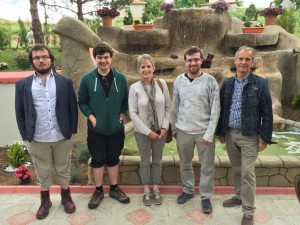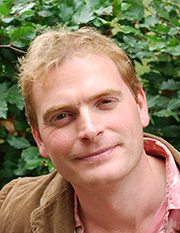By: Ben Camp, Nick Harper, Alex Pope, Debs Young (MA students, Department of Archaeology, University of Reading)
Day 1
After a night at the British Institute at Ankara the first place we visited was the Anatolian Civilisations Museum in Ankara. It is housed in a fantastic Ottoman building dating to the 15th century AD. Called a Han, it housed shops and accommodation for travellers, located in the old citadel. The artefacts throughout the museum were astounding and we would throughly recommend it to anyone travelling to Ankara.
Next we travelled with our bus and driver Selim Bey to Gordion, a site that has hosted such historic figures as Midas and Alexander the Great. We were greeted with the traditional British archaeological weather – rain and strong winds. First we went to Tumulus MM, stupefying for the size of the mound itself (53m high) and the size of the juniper logs covering the burial chamber, dated to 740 BC. Then we went to the mound of Gordion. We saw the Early Phrygian citadel and the Middle Phrygian gate. It was amazing to see how much was still standing.
Day 2
A long drive to Çatalhöyük, but it was worth every mile. Walking up the slope of the höyük (archaeological mound) in the sunshine towards the shelter only increased the sense of excitement and anticipation. Actually entering the shelter and standing in front of the 7000 BC village laid out before us was unbelievable. It is difficult to express in words quite what the site is like and know that this was a place that people chose to live in for generation after generation.
 Following the track across the mound with the pottery broken and discarded beneath our feet, we then entered the South Shelter and were left stunned at the panoramic vista of the many levels which dropped in front of us. We highly recommend a visit to Çatalhöyük, and to one of our group especially it was a much dreamt of visit.
Following the track across the mound with the pottery broken and discarded beneath our feet, we then entered the South Shelter and were left stunned at the panoramic vista of the many levels which dropped in front of us. We highly recommend a visit to Çatalhöyük, and to one of our group especially it was a much dreamt of visit.
We then drove the short distance to Boncuklu, a site even earlier than Çatalhöyük and which could prove in the future to be just as important. After an informative tour of the site, the guard invited us all for chay (tea), but which actually turned out to be a three course lunch eaten cross-legged on the floor of his family home. Wonderful food in the company of very welcoming and friendly people just added to an already fabulous day.
Acemhöyük was the last stop of the day, and after another long drive in torrential rain, we arrived just before the sun set and climbed precariously up the slippery mud slope clad in waterproofs, much to the amusement of the local villagers, to whom we no doubt looked like the archetypical English archaeologists! The heavily burnt site was too muddy to explore in detail but we were able to determine the extent and rich colours of the walls, brought to life by the wet conditions, especially when the setting sun shone its rays on the burnt Middle Bronze Age palaces, dated to 1650 BC.
A late night arrival at the hotel was greeted with enthusiasm by all after a long but wonderful day.
Day 3
The drive to Kültepe-Kaneš was not particularly long, and whilst the mound is visible from a distance, the karum, possibly the most important element of the site, is not. The site principally dates to the late third and early second millennia BC, including the Old Assyrian trading period, with the two most important levels of the lower town dating to this period. Recent excavations and survey have revealed that the well-preserved ruins extend even further into the beautiful countryside than previously expected. The lower town produced some 23,500 cuneiform texts of clay baked in the great conflagration that consumed the entire lower town in the middle of this period. The mound is also important, with recent discoveries of a massive administrative building dating to 2400 BC.
After Kültepe-Kaneš we then proceeded to Alişarhöyük, climbing the mound and inspecting the early twentieth century excavation trenches. Our final site for the third day was Alacahöyük, where both the museum and reconstructed tombs were amazing. The reliefs and sphinx gate were beautiful examples of Hittite art and after exploring the Hittite palace we had tea at a local café before proceeding to our lovely hotel at Hattusa, famous capital of the Hittites.
Day 4
We started the day by exploring the religious sanctuary of Yazılıkaya. The site is famous for its rock reliefs and it is easy to see why. The rock carvings were extremely impressive and the entire site had an atmosphere which indicated why the Hittite chose this place as a religious sanctuary.
We then travelled the short distance to the Hittite capital Hattusa. We spent the next six hours walking and exploring this massive site in the hot sun, looking at the many temples, royal buildings and gates which are scattered across the ancient city. Walking really gave us a great idea of what this ancient capital might have been like at the height of its power and it was a brilliant experience which we would thoroughly recommend. As we walked from one end of the city to the other we climbed 300m in height! After a lovely meal at Mehmet’s glorious Kale Otel we made the long drive back to Ankara in the dusk.
Day 5
In Ankara airport again, and it is with great sadness that we call time on the adventure. It has been the trip of a lifetime and the memories will last forever. Thanks to our driver Selim Bey and the British Institute in Ankara for facilitating the trip (particularly Selim Bey, who drove a crazy number of miles!). But special thanks must go to Professor Roger Matthews, who was the best host and guide we could have had. He really made the trip come alive. Until next time…
Special thanks to SAGES PGT fund and Reading International Office for their financial contributions to enable this field trip to happen, and to all our friends at BIAA.
For more photos from the trip, check out the album here.







